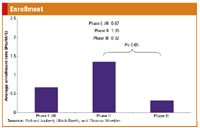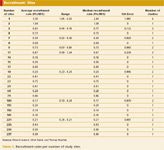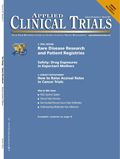Cancer Trials: Raising Accrual Rates
Applied Clinical Trials
Lessons learned from the recruitment of colorectal cander patients into clinical trials.
Cancer clinical trials are an important step in translating the benefits of the pharmaceutical/biotech industry's effort in drug discovery into clinical practice. However, a disappointingly low rate of subject accrual in trials is still observed. As an example, in the United States less than 4% of cancer patients enter a clinical trial.1 As a consequence, patient recruitment into clinical trials is the primary cause of study delay.2 Low accrual rates clearly have a negative impact, prolong the duration of the trials, delay the analysis of the results, or lead to early closure of studies. Understanding the factors that influence the enrollment rates is essential in order to support accurate and reliable estimation of subject enrollment in future trials. Colorectal cancer is one of the most common causes of cancer-related mortality worldwide, with over 1 million new cases and 560,000 deaths annually. In the United States, colorectal cancer accounts for approximately 165,700 new cases and 59,500 deaths per year.3 In Europe, it is estimated that 412,900 patients are diagnosed with colorectal cancer every year and 207,000 deaths will occur.4 As is the case with many cancer trials, colorectal cancer trials are also affected by subject enrollment problems. To better identify factors that influence the colorectal cancer patient accrual, we conducted a review of colorectal cancer studies published between January 2007 and October 1, 2008 and focused on collecting data related to lines of previous therapy, phase, number of sites, number of subjects enrolled, recruitment time, sponsor (industry, NIH, organization, and university), geographical region, line of treatment, and type of drug (five categories).

The main goal of our study was to describe the recruitment rate for a range of different studies as a foundation to estimate recruitment rates for future studies for systemic treatment in colorectal cancer. We were interested in finding indirect explanations for low or high recruitment rates and recorded the information on recruitment and characteristics of study design and localization.

JOSE LUIS PELAEZ INC/GETTY IMAGES
Overview
The literature review identified 43 studies describing clinical studies for novel treatments for patients with colorectal carcinoma, and data was collected from 37 studies. Four studies were omitted from analysis as recruitment data was incomplete. Two studies were also omitted because they did not recruit a majority of colorectal cancer patients. Altogether these studies enrolled a total of 13,702 patients. As shown in Table 1, the majority of trials evaluated patients with metastatic colorectal cancer (stage IV) (31 of 37 studies, 84%). Seventeen publications reported results from Phase III trials (46%), 14 studies reported results from Phase II trials (38%). Twenty-six studies were funded by industry (70%). Twenty-one studies were performed only in Europe (57%), and five studies were performed only in North America (14%). European and US centers took part in nine studies (24%). Seven studies (19%) were conducted at sites located in Asia Pacific.
Seven (19%) studies evaluated adjuvant/neo-adjuvant treatment and four studies (11%) investigated radiotherapy. Cytotoxic chemotherapies were the most frequently investigated agents (19 studies, 51%), followed by chemotherapies combined with targeted therapies (10 studies, 27%), and single agent targeted therapies (four studies, 11%). About half of the studies evaluated an agent as first-line treatment (21 studies, 57%).
Tumor stage and line of previous therapy
While observing the mean recruitment rates of four different categories of indications (advanced or metastatic colorectal cancer, colorectal cancer, rectal cancer, and nonresectable rectal carcinoma) reported in Table 1, as mentioned above 31 (84%) studies investigated patients with advanced or metastatic colorectal carcinoma. These studies enrolled patients with a rate of 0.83 Patients/Mont/Site (Pts/M/S) (range, 0.10 to 6.50). Adjuvant and neo-adjuvant studies in colorectal cancer recruited between 0.16 and 1.34 Pts/M/S with a mean of 0.43 Pts/M/S. Highest recruitment in this category was recorded for a Phase II study with 11 centers located in Germany evaluating a second-line treatment for colorectal cancer patients. Relatively low recruitment rates were reported for rectal carcinoma with 0.16 Pts/M/S (adjuvant) and 0.32 P/M/S (metastatic). No statistical correlation between the enrollment rate and the tumor stage/line of therapy was noted (P = 0.437).

Table 1. Subject enrollment rates for each individual element analyzed.
Phase of the trials
Table 1 shows the mean recruitment rates for Phase I and I/II, as well as for Phase II and III trials. Table 2 presents the mean number of sites, subjects, and accrual time for each phase of trials. Most clinical trials (n=17) were published in the Phase III setting closely followed by Phase II with 14 clinical studies.

Figure 1. The mean enrollment rates of colorectal cancer subjects per type of study phase.
Six Phase I or Phase I/II clinical studies were analyzed. For Phase I and I/II trials, the mean number of sites was four (range, 1 to 8) with a mean number of enrolled subjects of 35 (range, 20 to 49) and the mean accrual time was 21 months (range, 10 to 31). For Phase II trials, the mean number of sites was nine (range, 1 to 22), the mean number of subjects enrolled was 63 (range, 35 to 107), and the mean accrual time was 15 months (range, 6 to 32). For Phase III trials, the mean number of sites was 116 (range, 14 to 237), the mean number of subjects enrolled was 742 (range, 85 to 2034), and the mean accrual time was 28 months (range, 11 to 92).
As displayed in Table 1, the highest enrollment rate was observed for Phase II trials with a mean of 1.35 Pts/M/S (range, 0.23 to 6.50). The study with the highest enrollment rate in our analysis was in Phase II setting of metastatic colorectal cancer with a recruitment rate of 6.5 Pts/M/S. Mean enrollment rate of Phase II trial was followed by the enrollment rate of Phase I and I/II trials with a mean of 0.67 Pts/M/S (range, 0.15 to 1.81). The mean enrollment rate observed for Phase III trials was 0.32 Pts/M/S (range, 0.10 to 0.75). There was a significant difference in the mean enrollment rates among the phases of the trials (P = 0.004). Phase II trial enrollment rate versus Phase III trial enrollment rate was significant by pairwise comparison (P = 0.001, Fig 1).
Types of sponsor
For this analysis, we grouped the studies according to the sponsor supporting the study: industry, NIH, organization, and university (Table 1). More than two-thirds of the colorectal cancer trials were sponsored by industry (70%, 26 of 37 studies). NIH sponsored four studies (11%). A variety of organizations like national cancer societies, cancer associations, or foundations for cancer research sponsored five studies (14%). Universities sponsored two studies (5%).
The highest enrollment rate was observed for trials sponsored by universities with a mean rate of 1.41 Pts/M/S (range, 0.15 to 2.67). Trials sponsored by a variety of organizations enrolled subjects with a mean rate of 0.89 Pts/M/S. Trials sponsored by industry enrolled patients with a mean rate of 0.72 Pts/M/S (range, 0.10 to 6.50). Finally the lowest enrollment rate was observed with trials sponsored by the NIH with a mean of 0.60 Pts/M/S (range, 0.16 to 1.81). However, statistically, no association was observed between the enrollment rate and the trial sponsor (P = 0.757).
Trial locations
The studies reviewed were conducted in eight regions or groups of regions. For each of them, the mean enrollment rates were estimated (Table 1). It is apparent that most clinical trials reviewed are performed in Europe only (57%, 21 studies) or with contribution of European countries. Only 14% (five studies) of clinical trials were performed exclusively in North America.
The highest enrollment rate was observed for studies with sites located in North America, with a mean of 1.72 Pts/M/S (range, 0.23 to 6.50). However, those studies exclusively recruiting in North America were only Phase II trials (five studies).
Studies conducted with sites located in Europe only or jointly in Europe and Pacifica enrolled participants with a mean rate of 0.78 Pts/M/S (range, 0.16 to 2.67) and 0.77 Pts/M/S respectively. Trials involving sites located in North America, Europe, South America, South Africa, and Asia reached a mean enrollment rate of 0.43 Pts/M/S (range, 0.36 to 0.49). One trial with sites located in North America and Africa, and one trial with sites located in North America and Europe recruited patients with the same mean rate of 0.21 Pts/M/S. Studies with sites located in North America, Europe, and Pacifica were able to recruit patients with a mean of 0.16 Pts/M/S (range, 0.10 to 0.24).
Treatment modalities and drug combinations
The publications reviewed reported results from studies evaluating five categories of treatment including radiotherapy and adjuvant treatments. For each of them, a mean enrollment rate was estimated (Table 1). The highest mean enrollment rate was observed for trials for targeted therapy-based treatments with a mean of 2.05 Pts/M/S (range, 0.10 to 6.50). The study with highest recruitment in our series belonged to this category. Trials evaluating treatments based on combined chemotherapy with targeted therapy were able to recruit at a mean rate of 0.87 Pts/M/S (range, 0.21 to 2.67). Trials evaluating treatments based on a combined chemoradiotherapy or a cytotoxic chemotherapy were able to recruit subjects with a similar mean rate of 0.55 Pts/M/S (range, 0.15 to 1.34) and 0.50 Pts/M/S (range, 0.14 to 1.81) respectively. Trials evaluating treatments based on radiochemotherapy combined with targeted therapy were able to recruit subjects with a mean rate of 0.32 Pts/M/S. A small percentage of studies evaluated radiotherapy (11%, four studies) and adjuvant treatment (19%, seven studies). A statistical analysis was not able to demonstrate a significant difference in the mean rate among the type of treatment investigated (P = 0.642).
Line of treatment
Among the 37 trials reviewed, 21 (57%, Table 1) evaluated first-line treatment. Overall, these trials were able to enroll participants at a mean of 0.65 Pts/M/S (range, 0.15 to 2.67). Ten trials (27%) evaluated second-line treatment and the mean enrollment rate was 0.41 Pts/M/S (range, 0.14 to 1.34). Three trials (10%) evaluated third-line treatment with a mean enrollment rate of 2.94 Pts/M/S (range, 0.10 to 6.50). Three studies had broader inclusion criteria and were not restricted on a single specific line of treatment. One trial recruited subjects with up to one previous treatment. We decided to consider this drug as a first- or second-line treatment. The mean enrollment rate in this study was 0.77 Pts/M/S. Another trial recruited subjects as a second- or third-line treatment with a mean enrollment rate of 0.67 Pts/M/S. A third trial recruited in third- or fourth-line treatment with a mean enrollment rate of 0.24 Pts/M/S. The Kruskal-Wallis test, however, did not reveal any statistically significant correlation between the recruitment rates and the line of treatment (P = 0.379).

Table 2. Mean and median number of sites, patients, and accrual time per each type of study phase.
Number of participating sites
The number of sites participating and the corresponding mean enrollment rates are presented in Table 3. The mean rates for single-site studies, for single- and multiple site-studies, and for multiple site-studies only are presented in Table 4. Four publications reported results from trials involving a single site. These trials were able to enroll subjects with a mean rate of 3.30 Pts/M/S (range, 1.81 to 6.50). Thirty-three publications reported results from trials involving two to 237 sites with mean rates ranging from 0.14 Pts/M/S (118 participating sites) to 1.38 Pts/M/S (two participating sites). For the multiple-site studies, a mean enrollment rate of 0.46 Pts/M/S (range, 0.10 to 1.38) was estimated (Table 4). Based on all studies reviewed (single and multiple sites), a global mean enrollment rate of 0.77 Pts/M/S (range, 0.10 to 6.50) was estimated. The statistical analysis showed that the differences observed were not significant (P = 0.076).

Table 3. Recruitment rates per number of study sites.
Conclusion
Despite the fact that our study mainly intended to provide descriptive information on subject recruitment in clinical trials involving systemic treatment of those with colorectal cancer we can draw some conclusions from our analysis that are in line with published data in the field:
- The highest recruitment rates up to 6.5 P/M/S are observed for Phase II studies on novel agents.
- Multiple-site studies are designed in terms of study center localization and study design to achieve a median recruitment rate of approximately 0.5 Pts/M/S.
- Despite the trend to investigate novel agents in first or second line, investigations of novel agents in third or a subsequent line are particularly interesting as the recruitment rate was higher for these studies compared to studies in earlier line of therapy.
As recent data on the recruitment rates in clinical trials for colorectal carcinoma are missing, this analysis is an effort to close the gap and provides a data set supporting a more realistic estimation of recruitment rates for various types of clinical trials targeting colorectal carcinoma. Knowledge of the variables influencing recruitment will be an important guidance for study design, set-up, and operational aspects of clinical trials as well.

Table 4. Recruitment rates per type of study.
Additional factors not taken into account in this analysis like the inclusion/exclusion criteria and its impact on enrolling participants is significant and should be taken into account when planning a clinical trial in this indication.
Richard Joubert*, PhD, is Medical Research Scientist in the Oncology Group, e-mail: richard.joubert@i3global.com, Ulrich Raeth, MD, PhD, is Vice-President, Head of i3 Oncology, and Thomas Moehler, MD, PhD, is Senior Medical Director, Head of Therapeutic Area Oncology International, at i3, Taunustrasse 9, D-65183 Wiesbaden, Germany.
*To whom all coresspondence should be addressed.
References
1. P.N. Lara, D. A. Paterniti, C. Chiechi, C. Turrel, C. Morain, N. Horan, et al., "Evaluation of Factors Affecting Awareness of and Willingness to Participate in Cancer Clinical Trials," Journal of Clinical Oncology, 23 (36) 9282-9289 (2005).
2. C. N. Kraus, J. Rawlings, D. R. Anderson, and C. Kesler, "CRAFT, Facilitating Clinical Trial Execution Quality," AMIA Annual Symposium Proceedings, 1016 (2007).
3. D. M. Parkin, F. Bray, J. Ferlay, and P. Pisani, "Global Cancer Statistics, 2002," CA Cancer Journal for Clinicians 55 (2) 74-108 (2005).
4. J. Ferlay, P. Autier, M. Boniol, M. Heanue, M. Colombet, and P. Boyle, "Estimates of the Cancer Incidence and Mortality in Europe in 2006," Annals of Oncology 18 (3) 581-592 (2007).
5. J. G. Ford, M. W. Howerton, G. Y. Lai, T. L. Gary, S. Bolen, M. C. Gibbons, et al., "Barriers to Recruiting Underrepresented Populations to Cancer Clinical Trials: A Systematic Review," Cancer 112 (2) 228-242 (2008).
6. J. R. Wright, D. Crooks, P. M. Ellis, D. Mings, and T. Whelan, "Factors that Influence the Recruitment of Patients to Phase III Studies in Oncology," Cancer, 95 (7) 1584-1591 (2002).
7. W. S. Schain, "Barriers to Clinical Trials, Part II: Knowledge and Attitudes of Potential Participants," Cancer, Supplement, 74 (9) 2666-2671 (1994).
8. L. Howard L, I. de Salis, Z. Tomlin, G. Thornicroft, and J. Donovan, "Why is Recruitment to Trials Difficult? An Investigation into Recruitment Difficulties in an RCT of Supported Employment in Patients with Severe Mental Illness," Contemporary Clinical Trials, 30 (1) 40-46 (2009).
9. E. J. Mills, D. Seely, B. Rachlis, L. Griffith, P. Wu, K. Wilson, et al., "Barriers to Participation in Clinical Trials of Cancer: A Meta-Analysis and Systematic Review of Patient-Reported Factors, Lancet Oncology 7 (2) 141-148 (2006).
10. National Institutes of Health, "NIH Policy and Guidelines on the Inclusion of Women and Minorities as Subjects in Clinical Research," Amended October 2001, http://grants.nih.gov/grants/funding/women_min/guidelines_amended_10_2001.htm.
11. V. Murthy, H. M. Krumholz, and C. P. Gross, "Participation in Cancer Clinical Trials: Race-, Sex-, and Age-Based Disparities," Journal of the American Medical Association, 291 (22) 2720-2726 (2004).
12. M. Markman, J. Petersen, and R. Montgomery, "Influence of Tumor Type, Disease Status, and Patient Age on Self-Reported Interest Regarding Participation in Cancer Trials," Cancer, 107 (4) 849-853 (2006).

Improving Relationships and Diversifying the Site Selection Process
April 17th 2025In this episode of the Applied Clinical Trials Podcast, Liz Beatty, co-founder and chief strategy officer, Inato, discusses a number of topics around site engagement including community-based sites, the role of technology in improving site/sponsor relationships, how increased operational costs are impacting the industry, and more.